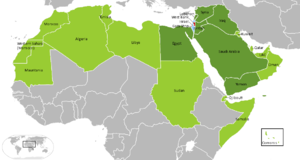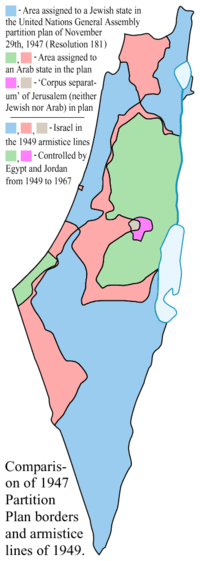Arab-Israeli conflict
2008/9 Schools Wikipedia Selection. Related subjects: Conflict and Peace
| Arab-Israeli conflict | |||||||
|---|---|---|---|---|---|---|---|
 Israel and members of the Arab League |
|||||||
| Arab League | Israel | ||||||
| Have been at war with Israel | Gaza Strip and West Bank | ||||||
|
|||||||
| Belligerents | |||||||
 Arab nations |
 Israel Israel |
||||||
|
Arab-Israeli conflict series
Participants
Israeli-Palestinian conflict · Israel-Lebanon conflict · Arab League · Soviet Union / Russia · Israel, Palestine and the United Nations · Iran-Israel relations · Israel-United States relations · Boycott of Israel Peace treaties and proposals
Israel-Egypt · Israel-Jordan |
|||||||
|
|||||
The Arab-Israeli conflict (Arabic: الصراع العربي الإسرائيلي Al-Ṣirāʿ al-ʿArabī al-'Isrā'īlī, Hebrew: הסכסוך הישראלי ערבי) spans roughly one century of political tensions and open hostilities. It involves the establishment of the Zionist movement and the creation of the modern State of Israel. In its early years, it also involves the establishment and independence of several Arab countries following World War I. The changing relationships between Arab nations and Israel are also initmately related, as is the Israeli-Palestinian conflict.
Scope of the conflict
Some uses of the term Middle East conflict refer to this matter; however, the region has been host to other conflicts not involving Israel (see List of conflicts in the Middle East).
Despite involving a relatively small land area and number of casualties, the conflict has been the focus of worldwide media and diplomatic attention for decades. Many countries, individuals and non-governmental organizations elsewhere in the world feel involved in this conflict for reasons such as cultural and religious ties with Islam, Arab culture, Christianity, Judaism or Jewish culture; or for ideological, human rights, strategic, or financial reasons; or because they are consistently exposed to the conflict by the media.
Some consider the Arab-Israeli conflict a part of (or a precursor to) a wider clash of civilizations between the Western World and the Arab or Muslim world. Others claim that the religious dimension is a relatively new matter in this conflict. This conflict has engendered animosities igniting numerous attacks on and by supporters (or perceived supporters) of opposing sides in countries throughout the world.
History of the conflict
End of 19th century-1948
Before World War I, the Middle East, including Palestine, had been under the control of the Ottoman Empire for nearly 500 years. During the closing years of their empire the Ottomans began to espouse their Turkish ethnic identity, asserting the primacy of Turks within the empire, leading to discrimination against the Arabs. The promise of liberation from the Ottomans led many Arabs to support the allied powers during World War I, leading to the emergence of widespread Arab nationalism. During this time tensions between the native Arab population of Palestine and the small, but growing, Jewish settler population in the area had begun to increase.
After World War I the area came under British rule as the British mandate of Palestine. Jewish immigration to Palestine increased. This, together with the worsening world wide economic situation and other internal factors, led to a large Arab immigration to the region and further increased tensions in the region. By 1931, 17 percent of the population of Palestine was comprised of Jews, an increase of six percent since 1922. Jewish immigration increased soon after the Nazis came to power in Germany, causing the Jewish population in Palestine to double. Palestinian Arabs saw this rapid influx of Jewish immigrants as a threat to their homeland and their identity as a people. Moreover, Jewish policies of purchasing land and prohibiting the employment of Arabs in Jewish owned industries and farms greatly angered the Palestinian Arab communities. Demonstrations were held as early as 1920, protesting what the Arabs felt were unfair preferences for the Jewish immigrants set forth by the British mandate that governed Palestine at the time. By 1936, escalating tensions led to the 1936–1939 Arab revolt in Palestine.
In response to Arab pressure, the British Mandate authorities greatly reduced the number of Jewish immigrants to Palestine (see White Paper of 1939 and the Exodus ship). These restrictions remained in place until the end of the mandate, a period which coincided with the Nazi Holocaust and the flight of Jewish refugees from Europe. As a consequence, most Jewish entrants to Palestine were illegal (see Aliyah Bet), causing further tensions in the region. Following several failed attempts to solve the problem diplomatically, the British asked the newly formed United Nations for help. On 15 May 1947 the UN appointed a committee, the UNSCOP, composed of representatives from eleven states. To make the committee more neutral, none of the Great Powers were represented. After five weeks of in-country study, the commission recommended creating a partitioned state with separate territories for the Jews and the Arabs in Palestine . This "two state solution" was accepted with resolution 181 by the UN General Assembly in November 1947 by 33 votes to 13 with 10 abstentions. The Arab states, which constituted the Arab League, voted against. On the ground, Jewish and Palestinian Arab were fighting openly to control strategic positions in the region. Several major atrocities were committed by both sides.
On 14 May 1948, one day before the end of the British Mandate of Palestine, Israel declared its independence and sovereignty on the portion partitioned by UNSCOP for the Jewish state. The next day, the Arab League reiterated officially their opposition to the "two-state solution" in a letter to the UN. That day, the armies of Egypt, Lebanon, Syria, Jordan, and Iraq invaded the territory partitioned for the Arab state, thus starting the 1948 Arab-Israeli War. The nascent Israeli Defense Force repulsed the Arab nations from part of the occupied territories, thus extending its borders beyond the original UNSCOP partition. By December of 1948, Israel controlled all of the mandate Palestine except the West Bank and the Gaza Strip which remained under the control of Jordan and Egypt respectively. Prior and during this conflict, 711,000 Palestinians Arabs fled their original lands or were expelled by the Israeli army to become Palestinian refugees. The War came to an end with the signing of the 1949 Armistice Agreements between Israel and each of its Arab neighbors. This 1949 armistice line, the so-called green line, is to this day the internationally-recognized border of the state of Israel. It is often referred to as the "pre-1967" border.
1949-June 11, 1967
In 1956, Egypt closed the Straits of Tiran to Israeli shipping, and blockaded the Gulf of Aqaba, in contravention of the Constantinople Convention of 1888. Many argued that this was also a violation of the 1949 Armistice Agreements. On July 26, 1956, Egypt nationalized the Suez Canal Company, and closed the canal to Israeli shipping.
Israel responded on October 29, 1956, by invading the Sinai Peninsula with British and French support. During the Suez Canal Crisis, Israel captured the Gaza Strip and Sinai Peninsula. The United States and the United Nations soon pressured it into a ceasefire. Israel agreed to withdraw from Egyptian territory. Egypt agreed to freedom of navigation in the region and the demilitarization of the Sinai. The United Nations Emergency Force (UNEF) was created and deployed to oversee the demilitarization. The UNEF was only deployed on the Egyptian side of the border, as Israel refused to allow them on its territory.
On May 19, 1967, Egypt expelled UNEF observers, and deployed 100,000 soldiers in the Sinai Peninsula. It again closed the Straits of Tiran to Israeli shipping, returning the region to the way it was in 1956 when Israel was blockaded.
On May 30, 1967, Jordan entered into the mutual defense pact between Egypt and Syria. In response, on June 5 Israel sent almost all of its planes on what they believed to be a preemptive mission in Egypt. The Israeli Air Force (IAF) destroyed most of the surprised Egyptian Air Force, then turned east to pulverize the Jordanian, Syrian and Iraqi air forces. This strike was the crucial element in Israel's victory in the Six-Day War.
June 12, 1967-1973
In the summer of 1967, Arab leaders met in Khartoum in response to the war, to discuss the Arab position toward Israel. They reached consensus that there should be:
- No recognition of the State of Israel.
- No peace with Israel.
- No negotiations with Israel.
In 1969, Egypt initiated the War of Attrition, with the goal of exhausting Israel into surrendering the Sinai Peninsula. The war ended following Nasser's death in 1970.
On October 6, 1973, Syria and Egypt attacked Israel on Yom Kippur, overwhelming the surprised Israeli military. The Yom Kippur War accommodated indirect confrontation between the US and the Soviet Union. When Israel had turned the tide of war, the USSR threatened military intervention. The United States, wary of nuclear war, secured a ceasefire on October 25.
1974-2000
- Egypt
Following the Camp David Accords of the late 1970s, Israel and Egypt signed a peace treaty in March, 1979. Under its terms, the Sinai Peninsula returned to Egyptian hands, and the Gaza Strip remained under Israeli control, to be included in a future Palestinian state.
- Jordan
In October, 1994, Israel and Jordan signed a peace agreement, which stipulated mutual cooperation, an end of hostilities, and a resolution of other unsorted issues.
- Iraq
In June, 1981, Israel successfully attacked and destroyed newly built Iraqi nuclear facilities in Operation Opera.
During the Gulf War, Iraq fired 39 missiles into Israel, in the hopes of uniting the Arab world against the coalition which sought to liberate Kuwait. At the behest of the United States, Israel did not respond to this attack in order to prevent a greater outbreak of war.
- Lebanon
In 1970, following an extended civil war, King Hussein expelled the PLO from Jordan. The PLO resettled in Lebanon, whence it staged raids into Israel. In 1981, Syria, allied with the PLO, positioned missiles in Lebanon. In June, 1982, Israel invaded Lebanon. Within two months, the PLO agreed to withdraw thence.
In March, 1983, Israel and Lebanon signed a ceasefire agreement. However, Syria pressured President Amin Gemayel into nullifying the truce in March, 1984. By 1985, Israeli forces had mostly withdrawn from Lebanon, and Israel completed its withdrawal in May 2000, leaving behind a power vacuum which Syria and Hezbollah soon filled.
- Palestinians
In 1987, the First Intifada began. The PLO was excluded from negotiations to resolve it until it recognized Israel and renounced terrorism the following year. In 1993, Israel and the PLO signed the Oslo Accords, and their Declaration of Principles, which, together with the Road map for peace, have been loosely used as the guidelines for Israeli-Palestinian relations since.
2000-present
As a response to the al-Aqsa Intifada, Israel raided facilities in major urban centers in the West Bank in 2002. Violence again swept through the region. Israeli Prime Minister Ariel Sharon began a policy of unilateral withdrawal from the Gaza Strip in 2003. This policy was fully implemented in August, 2005.
In July, 2006, Hezbollah fighters crossed the border from Lebanon into Israel, attacked and killed eight Israeli soldiers, and kidnapped two others, setting off the 2006 Lebanon War. A UN-sponsored ceasefire went into effect on August 14, 2006, officially ending the conflict.
On September 6, 2007, in Operation Orchard, Israel bombed a northern Syrian complex which was suspected of holding nuclear missiles from North Korea.
